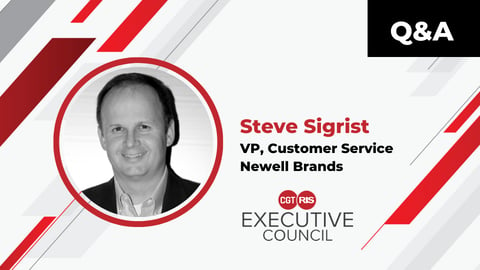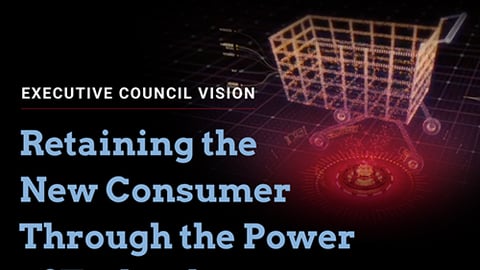The Future of Tech-Powered Commerce: Up Close with Publicis Sapient’s Liz Papasakelariou
Over the last two decades, Liz Papasakelariou has worked with consumer goods brands on everything from brand launches to go-to-market strategies. She’s had extensive agency experiences, working with brands such as Kellogg’s, Charmin, Bounty, Always for the US market while at Leo Burnett.
Now, as EVP, executive client partner, at Publicis Sapient, Papasakelariou leads the firm’s consumer products industry vertical for North America, helping CG stalwarts like Nestle and L’Oreal on their digital and data transformation journeys.
We reached out to the CGT/RIS Executive Council member to get her perspective on what’s key for today’s CGs when it comes developing a data strategy, the future of social commerce, the potential of blockchain and more.
CGT: You’ve helped a number of legacy CG brands accelerate their digital transformation, including Procter & Gamble, Nestle and L’Oréal, among others. What have you found that large CPGs such as these have in common when it comes to the needs and challenges in developing a data strategy?
The first thing CG companies need to understand is that given the amount of data available and the changing patterns of consumer behavior, they are not selling just products anymore, but a relationship.
EC Member Shares
How long have you been with Publicis Sapient?
I have been with Publicis Sapient for 7 years.
What has been your “pandemic pastime?”
Cooking a course menu. Getting the right timing from course to course is an amazing challenge.
What’s on your travel wish list?
For years, I have had Portugal and Croatia on my list. As we start to open up again, I am hoping to make a few quick getaways.
Favorite Netflix/Amazon/Hulu binge series?
I have so many, it’s hard to choose! My top are “Schitt’s Creek,” “Killing Eve,” “White Lotus,” “Unorthodox,” and recently loving “Ted Lasso.”
Which book is on your nightstand or to-do list?
“The Splendid and The Vile” by Erik Larson. I love the way he mixes real history with fictional stories.
There are two main challenges CG brands face when it comes to developing a data strategy. First is the ownership of first-party data. CG brands often do not have access to this data as traditionally most sales are done through retailers. It is key for CG brands to develop direct-to-consumer and value exchange strategies to generate the opportunities to capture first-party data so that they can better understand their customers and continuously adapt to their evolving needs.
The second challenge is not knowing what to do with the data once they acquire it. CGs should consider a few action items as it relates to gathering data and turning it into actionable insights:
Organize a single, 360-degree view of your consumer across all brands: This will be beneficial in two simple ways. Instead of limiting itself to transactional and two-way dialogues (one consumer buying one brand), the whole company can take advantage of cross brand learnings and insights. In addition, they can find a way to keep consumers engaged throughout the full lifetime journey.
Keep data relevant and current: Another characteristic of Big Data is the velocity of which new information is acquired. It keeps coming. With that there is a need for CGs to make the right investment for continuous improvement of their data. Having the latest insights can help inform business decisions in real time and stay ahead of the trends.
Establish a strong governance process: Real transparency and control for the consumer is a must. Governance process and consent tools manage how information is collected, when it can be used, and for what purpose.
Unlock agility: Many CG companies were built to benefit from economies of scale but contemporary behavior put a premium on personalization and segment-specific solutions so CGs have to evolve operational capabilities and digitally transform their internal processes to enable agility. This can be done through supply chain modernization and marketing automation.
CGT: What do you see as the real future of social commerce, and what are some of the technologies that you think will get us there?
Social commerce is an exciting and dynamic space that presents a lot of opportunity for CG brands, but they must remember that in social commerce the sale only happens when there is engagement. Not only is it important to make sure they share content that their audience values, but also to continue gathering insights to learn more about the audience.
CGs should also take advantage of characteristics of the platform to build trust with the audience and create some impulse moments. Below are a few examples of how technology is enabling engagement through social commerce:
Social platforms continue to evolve: Social platforms are continuously evolving and building upon their commerce capabilities. For example, Verishop and Snap, Inc. teamed up to launch Verishop Mini, which allows Snapchat users to browse and purchase apparel and beauty products within the app. Snapchat users can also try beauty products virtually through AR.
TikTok has also jumped into the e-commerce space. TikTok partnered with Shopify to launch TikTok Shopping, which allows Shopify merchants with a TikTok for Business accounts to include a shopping tab on their profile. Merchants also have the ability to build a mini storefront.
Livestream shopping will continue to grow: Consumers have shifted towards online shopping and now want more. This is especially a great channel for small businesses since it’s relatively easy and quick to set up and provides them great opportunities to communicate with their customers in a deeper, more engaging way.
AR can create the ultimate product experience: CG brands can use 3D integration through AR for the ultimate product experience. For example, Dermalogica developed a VR e-commerce storefront highlighting its new products. The store includes an avatar of Dermalogica’s VP of Tech & Innovation, Dr. Angela Murphy, speaking about the products. It also provides educational videos, an aesthetician finder, and the company’s skin analysis tool.
CGT: What are today's CG brands most challenged by regarding social commerce?
As mentioned, social commerce is a dynamic space that consumers are getting increasingly comfortable navigating. A few challenges include:
Scale: One major challenge CG brands face when it comes to social commerce is scaling the engagement and efforts. CG brand should seek insights from past engagement data and establish a process to operationalize the efforts.
Rewarding consumers: Once CGs have done all the hard work to engage their consumers and have been rewarded with a purchase, they must build loyalty. CGs should make consumers feel rewarded by validating their purchase and providing special, personalized perks.
Authenticity: CG brands must be mindful of the way they’re selling their products on social. If they push/sell too hard, it can potentially turn customers off.
CGT: You have clients who are exploring the potential of blockchain: Would you say adoption (or at least interest) is accelerating? What’s causing the most amount of friction with the use of blockchain in CG right now?
Blockchain in the CPG space is still in its infancy stage. One use case of blockchain is that it can offer consumers a view of the origin of their product, providing full traceability from origin to shelf to home. In this era when consumers desire full transparency from brands, this use case offers real time product information at their fingertips. However, currently CGs do not have the right technologies in place and rules have not been established across the category.
CGT: Similarly, NFTs and the metaverse have become this year’s buzzwords, but some brands are making real investments. Where do you see the potential for consumer goods brands (if you do see potential)?
An investment in the NFT space depends on the company’s answers to the following questions: Does it make sense for the brand? Can it be done authentically? What is the role of NFTs for the particular product or brand?
For example, it may make sense in the luxury space. I recently read an article where NFTs were sold to help guarantee ownership of barrels of wine. The owner has the advantage of being a part of an overall experience – from visiting the vineyard and tracking the wine’s progress to grape picking and sipping.







